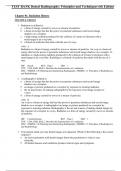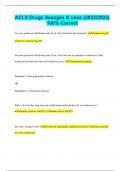TEST BANK Dental Radiography: Principles and Techniques 6th Edition
Chapter 01: Radiation History
MULTIPLE CHOICE
1. Radiation is defined as
a. a form of energy carried by waves or streams of particles.
b. a beam of energy that has the power to penetrate substances and record image
shadows on a receptor.
c. a high-energy radiation produced by the collision of a beam of electrons with a
metal target in an x-ray tube.
d. a branch of medicine that deals with the use of x-rays.
ANS: A
Radiation is a form of energy carried by waves or streams of particles. An x-ray is a beam of
energy that has the power to penetrate substances and record image shadows on a receptor. X-
radiation is a high-energy radiation produced by the collision of a beam of electrons with a
metal target in an x-ray tube. Radiology is a branch of medicine that deals with the use of x-
rays.
DIF: Recall REF: Page 1 OBJ: 1
TOP: CDA, RHS, III.B.2. Describe the characteristics of x-radiation
MSC: NBDHE, 2.0 Obtaining and Interpreting Radiographs | NBDHE, 2.1 Principles of Radiophysics
and Radiobiology
2. A radiograph is defined as
a. a beam of energy that has the power to penetrate substances and record image
shadows on a receptor.
b. an image or picture produced on a receptor by exposure to ionizing radiation.
c. the art and science of making radiographs by the exposure of an image receptor to
x-rays.
d. a form of energy carried by waves or a stream of particles.
ANS: B
An x-ray is a beam of energy that has the power to penetrate substances and record image
shadows on a receptor. A radiograph is an image or picture produced on a receptor by
exposure to ionizing radiation. Radiography is the art and science of making dental images by
the exposure of a receptor to x-rays. Radiation is a form of energy carried by waves or streams
of particles.
DIF: Comprehension REF: Page 1 OBJ: 1
TOP: CDA, RHS, III.B.2. Describe the characteristics of x-radiation
MSC: NBDHE, 2.0 Obtaining and Interpreting Radiographs | NBDHE, 2.1 Principles of Radiophysics
and Radiobiology
3. Your patient asked you why dental images are important. Which of the following is the correct
response?
a. An oral examination with dental images limits the practitioner to what is seen
clinically.
b. All dental diseases and conditions produce clinical signs and symptoms.
, c. Dental images are not a necessary component of comprehensive patient care.
d. Many dental diseases are typically discovered only through the use of dental
images.
ANS: D
An oral examination without dental images limits the practitioner to what is seen clinically.
Many dental diseases and conditions produce no clinical signs and symptoms. Dental images
are a necessary component of comprehensive patient care. Many dental diseases are typically
discovered only through the use of dental images.
DIF: Application REF: Page 1 OBJ: 2
TOP: CDA, RHS, III.B.2. Describe the characteristics of x-radiation
MSC: NBDHE, 2.0 Obtaining and Interpreting Radiographs | NBDHE, 2.5 General
4. The x-ray was discovered by
a. Heinrich Geissler.
b. Wilhelm Roentgen.
c. Johann Hittorf.
d. William Crookes.
ANS: B
Heinrich Geissler built the first vacuum tube in 1838. Wilhelm Roentgen discovered the x-ray
on November 8, 1895. Johann Hittorf observed in 1870 that discharges emitted from the
negative electrode of a vacuum tube traveled in straight lines, produced heat, and resulted in a
greenish fluorescence. William Crookes discovered in the late 1870s that cathode rays were
streams of charged particles.
DIF: Recall REF: Page 1 | Page 2 OBJ: 4
TOP: CDA, RHS, III.B.2. Describe the characteristics of x-radiation
MSC: NBDHE, 2.0 Obtaining and Interpreting Radiographs | NBDHE, 2.5 General
5. Who exposed the first dental radiograph in the United States using a live person?
a. Otto Walkoff
b. Wilhelm Roentgen
c. Edmund Kells
d. Weston Price
ANS: C
Otto Walkoff was a German dentist who made the first dental radiograph. Wilhelm Roentgen
was a Bavarian physicist who discovered the x-ray. Edmund Kells exposed the first dental
radiograph in the United States using a live person. Price introduced the bisecting technique in
1904.
DIF: Recall REF: Page 3 OBJ: 5
TOP: CDA, RHS, III.B.2. Describe the characteristics of x-radiation
MSC: NBDHE, 2.0 Obtaining and Interpreting Radiographs | NBDHE, 2.5 General
6. Current fast radiographic film requires ____% less exposure time than the initial exposure
times used in 1920.
a. 33
b. 98
c. 73
, d. 2
ANS: B
Current radiographic film requires more than 33% less exposure time than times in 1920.
Current fast radiographic film requires 98% less exposure time than the initial exposure times
used in 1920, which, in turn, reduces the patient’s exposure to radiation. Current radiographic
film has reduced exposure time more than 73%. Current radiographic film requires less than
2% of the initial exposure times needed in 1920.
DIF: Comprehension REF: Page 3 OBJ: 6
TOP: CDA, RHS, III.B.2. Describe the characteristics of x-radiation
MSC: NBDHE, 2.0 Obtaining and Interpreting Radiographs | NBDHE, 2.5 General
7. Who modified the paralleling technique with the introduction of the long-cone technique?
a. C. Edmund Kells
b. Franklin W. McCormack
c. F. Gordon Fitzgerald
d. Howard Riley Raper
ANS: C
C. Edmund Kells introduced the paralleling technique in 1896. Franklin W. McCormack
reintroduced the paralleling technique in 1920. F. Gordon Fitzgerald modified the paralleling
technique with the introduction of the long-cone technique in 1947. This is the technique
currently used. Howard Riley Raper modified the bisecting technique and introduced the bite-
wing technique in 1925.
DIF: Recall REF: Page 4 OBJ: 7
TOP: CDA, RHS, III.B.2. Describe the characteristics of x-radiation
MSC: NBDHE, 2.0 Obtaining and Interpreting Radiographs | NBDHE, 2.5 General
8. Which of the following is an advantage of digital imaging?
a. Increased patient radiation exposure
b. Increased patient comfort
c. Increased speed for viewing images
d. Increased chemical usage
ANS: C
Patient exposure is reduced with digital imaging. Digital sensors are more sensitive to x-rays
than film. Digital sensors are rigid and bulky, causing decreased patient comfort. The image
from digital sensors is uploaded directly to the computer and monitor without the need for
chemical processing. This allows for immediate interpretation and evaluation. The image from
digital sensors is uploaded directly to the computer and monitor without the need for chemical
processing.
DIF: Comprehension REF: Page 4 OBJ: 7
TOP: CDA, RHS, I.B.2. Demonstrate basic knowledge of digital radiography
MSC: NBDHE, 2.0 Obtaining and Interpreting Radiographs | NBDHE, 2.5 General
9. Which discovery was the precursor to the discovery of x-rays?
a. Beta particles
b. Alpha particles
c. Cathode rays
, d. Radioactive materials
ANS: C
Beta particles are fast moving electrons emitted from the nucleus of radioactive atoms and are
not associated with x-rays. Alpha particles are emitted from the nuclei of heavy metals and are
not associated with x-rays. Wilhelm Roentgen was experimenting with cathode rays when he
discovered x-rays. Radioactive materials are certain unstable atoms or elements that are in the
process of spontaneous disintegration or decay.
DIF: Comprehension REF: Page 2 OBJ: 4
TOP: CDA, RHS, III.B.2. Describe the characteristics of x-radiation
MSC: NBDHE, 2.0 Obtaining and Interpreting Radiographs | NBDHE, 2.5 General
10. Which of the following would you place in the patient’s mouth in order to take dental x-rays?
a. Image
b. Image receptor
c. Radiograph
d. Dental radiograph
ANS: B
An image is a picture or likeness of an object. An image receptor is the recording medium
(film, phosphor plate, or digital sensor) that is placed in the patient’s mouth to record the
image produced by the x-rays. A radiograph is an image of two-dimensional representation of
a three-dimensional object. A dental radiograph is the dental image produced on a recording
medium.
DIF: Application REF: Page 1 OBJ: 1
TOP: CDA, RHS, III.B.2. Describe the characteristics of x-radiation
MSC: NBDHE, 2.0 Obtaining and Interpreting Radiographs | NBDHE, 2.5 General





